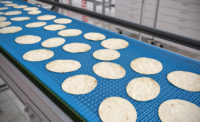Manufacturers and processors looking to invest in x-ray product inspection and fat analysis (FA) systems have a great deal to consider ahead of making a purchasing decision. Making the right decision the first time can mean the difference between installing a machine that earns its keep and one that ultimately costs more than the value it adds to an operation.
It is no longer a question of purchasing the system with the lowest up-front investment level, rather it’s a case of calculating how much the system will cost over its lifetime to maintain error-free, reliable service throughout production cycles.
Cost vs. reward must be taken into consideration when determining whether the investment itself can be justified. In order to understand the value a system can add to an operation, operators must take an all-inclusive view that encompasses several production realities–from the environment the system will operate in to the cost of servicing and everything in between. This analysis of the lifetime cost of the system in question–combined with the purchase price—is referred to as total cost of ownership (TCO).
Effectively calculating TCO
An iceberg metaphor is often employed to demonstrate the theory behind TCO.
The upfront costs, or the visible costs (the section of the iceberg above the water), include the cost of hardware and associated software, installation, calibration and shipping. These types of values are often present on the quotation or proposal.
The hidden costs (those beneath the water) are those associated with areas such as servicing the system to keep the production line running smoothly, any upgrades required to keep the system operating and the cost of any downtime associated with poor reliability.
There is also a need to consider the cost of spare parts, or replacement parts needed to keep a production line running.
Expert equipment suppliers should always recommend that customers consider all costs associated with installation to understand the true value of the system being proposed, followed by the operational costs.
Operationally, TCO is effectively how much a customer has to reinvest in a system to achieve a desired end result, which is to run error-free and reliably through the production cycle.
In order to fully understand what this will entail, a number of areas need to be scrutinized.
Robustness
A system designed to be placed into a specific environment will be far better equipped to perform its functions reliably than one that has simply been adapted from an existing model. X-ray product inspection systems have been developed as a result of working closely with customers to understand the challenges faced and to address them accordingly. For example, systems dedicated to the inspection of meat and poultry products should ideally follow the North American Meat Institute (NAMI) design standards, as well as IP69 for ingress protection.
Sanitary design is critical in food and beverage environments and covers a wide range of areas, from eliminating potential harborage areas to avoid accumulations of product, to ensuring the system can be washed down and sanitized as quickly as possible to avoid prolonged periods of downtime. What is important to establish is the correct level of hygiene and sanitation for specific operations and environments, while still being profitable, protecting the consumer and the brand and maintaining compliance with governmental standards and regulations. Systems that are designed from the ground up can check the necessary boxes required for sanitary construction along the way. Just because it’s an inspection technology doesn’t mean there should be a compromise on standards or expectations.
Overall lifespan of the system and its components
This is very important, as replacement or spare parts represent additional costs to manufacturers.
X-ray machines require higher power for generators, therefore it is important to factor in the cost of replacing the generator and other wear parts within the system when looking at TCO, alongside the reinvestment cost associated with regular preventative maintenance services. A well-maintained x-ray or FA system will often achieve a lifespan in excess of 10 years, and there are several instances of systems still operating perfectly to specification out to 15 years. These extra years following the full depreciation of a system are often referred to as “free years” of operation.
Machines built using robust components designed for longevity significantly increase the likelihood of enjoying the benefits of these extra years of operation.
Annual running costs
The annual running cost of a machine is an important variable to consider in a TCO analysis, and is based on power and time, such as the 1.1 kW power of a device. Some systems may also require the use of water and compressed air in the course of operations, the cost of supplying, which should also be included. Alongside this, the time involved in the maintenance and sanitation of the system must also be factored in.
Installations with frequent washdown regimens, for example, can lead to downtime while the process is carried out. Systems designed to be quick and easy to sanitize, ideally by a single operator in a matter of minutes, can significantly reduce this downtime, leading to improved productivity.
Finally, ease of use will have an impact on TCO in terms of labor hours and their associated costs. A system that is simple and intuitive to operate will save a considerable amount of time where product setup and changeovers are required, contributing further to reduced downtime.
Value-added to operations
While some x-ray and FA systems will allow manufacturers to tick the boxes required for compliance with regulations associated with contaminant detection, such as HACCP, some go considerably further in their capabilities, allowing operators to expand on the measurements to add further value simultaneously.
Tasks such as counting the number of components within a product, measuring mass, thickness and even feeding back to a filler if levels fall outside of the correct parameters can help manufacturers to reduce wastage and costs, and are possible due to sophisticated imaging technology that enables several elements of an image to be interrogated at the same time. These additional benefits and savings should be factored into TCO analyses.
Conclusion
TCO is not simply the initial cost of a system, plus the warranty period and expected life of that system.
The definition of TCO will inevitably vary from user to user, based on the specifics of the production line, the products being manufactured, and ultimately, the system being purchased itself.
Of course, the investment cost will be a contributing factor, but it must be combined with the lifecycle cost of running the system regularly and efficiently, with preventive maintenance, spare parts, upgrades, robustness and ease of use taken into consideration.
Any capital equipment purchase represents significant investment, therefore it is advisable when gathering the information necessary to make a decision to work in partnership with a supplier who can provide quality data and information specifically tailored to your operation.
In doing so, customers will ultimately find what they seek–a supplier that offers the greatest value, accuracy and reliability in a system at the lowest TCO in the industry.






